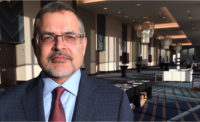Karen Erger, senior vice president of practice risk management at insurance broker Lockton Cos., warns engineers and architects to be on guard against contract language that would effectively burden them with fiduciary responsibility for a project.
A fiduciary responsibility binds a professional to his or her client via a special legal and ethical relationship of trust. Physicians and accountants are covered by that standard, which requires that the client or customer’s interest is paramount.
When such language is proposed for architects or engineers, it is generally the exception. The American Institute of Architects isn't overly concerned and via a spokesman says the subject "hasn't come up among our members as a pressing issue."
But a construction industry consultant, Ujjval Vijas, has been campaigning for designers to be subject to such a standard, claiming it is in the best interests of the industry. Vijas says his ideas would constitute a disruptive paradigm shift for the better. He admits he is sometimes met with scorn. But he floated his proposal to several hundred wary listeners at the International Risk Management Institute Construction Risk Conference in Houston in early November.
The cost of liability insurance, most agree, could rise sharply if such a standard was widely adopted.
Had Erger been present at the Houston conference, she would have added a sharp critical perspective. Interviewed by telephone recently, she argued that the traditional, professional standard of care that design professionals owe their clients is more than sufficient. Simply put, architects and engineers have a duty to perform in a manner that is reasonable to meet the professional standard observed by a similarly situated design professional at the same time and place.
The architect or engineer, under the professional standard of care, is not required to be perfect or guarantee the outcome of a project.
If an engineer is sued for negligence, the issue can be settled in court with the help of other engineers and design professionals acting as expert witnesses.
The architect or engineer, under the professional standard of care, is not required to be perfect or guarantee the outcome of a project, says Erger.
However, some project owners – or, more specifically their lawyers – have been inserting contract language that a court might later interpret as establishing a fiduciary responsibility.
Erger advises designers to be on the lookout for phrases like the engineer “accepts a relationship of trust and confidence” or that the engineer is going to “act in the owner’s best interests.”
While these may sound innocuous, accepting a fiduciary responsibility for a project could put an architect or engineer in a difficult situation should a dispute with the owner wind up in court.
For example, a court could cite contract language to say a design professional had a fiduciary responsibility to guarantee the “project is constructed in strict conformance with the construction documents, despite the fact that the contract makes it quite clear that the contractor, and not the design professional, is responsible for means and methods, and for following the plans,” Erger wrote about the subject several years ago.
For one large engineering firm, the result was a costly $52.1-million judgment after the city of Victorville in California took it to court in 2010 for breach of fiduciary responsibility, along with professional negligence.
While there is a place for fiduciary responsibility, it’s not a fair or appropriate obligation to thrust on a design professional who does not have anything like complete authority over a project, says Erger. Rather, the design process is typically a collaborative one in which the owner and other players also have lots of say.
“It simply does not fit,” Erger says. “It isn’t appropriate to hold the design professional to a fiduciary standard. The standard of care works, They (design professionals) use their judgement and experience to select a reasonable design for the project. We don’t call on them to guarantee the results.”
By signing a contract with fiduciary responsibility language, architects and engineers can also put the professional liability insurance coverage at risk as well.
The professional liability coverage that engineers and architects typically have doesn’t cover breach of fiduciary responsibility. And in some states, if you are found to have willfully breached your fiduciary responsibility, you could find yourself hit with penalties as well.
Still, some design professionals may find it difficult to push back against contract language that can sound fairly innocent and not necessarily all that controversial.
After all, it is seemingly awkward to reject language calling for “relationship of trust and confidence” and what architect or engineer doesn’t have the owner’s best interests at heart?
It’s up to the design professional to push back and explain this language is unnecessary and could have unintended consequences, such as short-circuiting the very insurance coverage most project owners require architects and engineers to carry.
“The architect owes the duty of good faith and will try and implement what the owner wants,” Erger says.





Post a comment to this article
Report Abusive Comment